前言
按照官网调试代码、网上各种步骤来走(还收费)都不行
结果发现是防火墙问题
公司服务器安装的ufw使用失效,导致端口号放行添加失败
换用firewall-cmd成功
现在免费放下代码,气死他们收费的
目录
├── home
│ ├── katja
│ │ ├── samba
│ │ │ ├── install_samba.sh
│ │ │ ├── smb.conf
│ │ │ ├── xxxxx.deb
│ │ │ ├── ...
│ │ │ └──
│ │ ├── localoss
│ │ │ ├── test (被共享的目录)
│ │ │ └──
│ │ └──
│ └──
└──
代码
install_samba.sh
#!/bin/bash
# -*- coding: utf-8 -*-
# @Time : 2022/11/14 14:38
# @Author: katja
# @File : install_samba.sh
# @Desc : samba 共享文件夹
#
path=/home/katja/samba
share_user=tps_share
share_group=sambashare
share_path=/home/katja/localoss
# 安装samba
is_exist(){
package=$1
package_deb=$2
if test ! -z "$(dpkg -l | grep -w $package)";then
echo -e "$package exist "
else
dpkg -i ${path}/$package_deb
fi
}
install(){
is_exist python3-ldb python3-ldb_2%3a2.2.3-0ubuntu0.20.04.3_amd64.deb
is_exist libldb2 libldb2_2%3a2.2.3-0ubuntu0.20.04.3_amd64.deb
is_exist libsmbclient libsmbclient_2%3a4.13.17~dfsg-0ubuntu1.20.04.1_amd64.deb
is_exist libwbclient0 libwbclient0_2%3a4.13.17~dfsg-0ubuntu1.20.04.1_amd64.deb
is_exist samba-libs samba-libs_2%3a4.13.17~dfsg-0ubuntu1.20.04.1_amd64.deb
is_exist python3-dnspython python3-dnspython_1.16.0-1ubuntu1_all.deb
is_exist python3-crypto python3-crypto_2.6.1-13ubuntu2_amd64.deb
is_exist python3-tdb python3-tdb_1.4.3-0ubuntu0.20.04.1_amd64.deb
is_exist python3-samba python3-samba_2%3a4.13.17~dfsg-0ubuntu1.20.04.1_amd64.deb
is_exist samba-common samba-common_2%3a4.13.17~dfsg-0ubuntu1.20.04.1_all.deb
is_exist samba-common-bin samba-common-bin_2%3a4.13.17~dfsg-0ubuntu1.20.04.1_amd64.deb
is_exist tdb-tools tdb-tools_1.4.3-0ubuntu0.20.04.1_amd64.deb
is_exist samba samba_2%3a4.13.17~dfsg-0ubuntu1.20.04.1_amd64.deb
is_exist attr attr_1%3a2.4.48-5_amd64.deb
is_exist libibverbs1 libibverbs1_28.0-1ubuntu1_amd64.deb
is_exist ibverbs-providers ibverbs-providers_28.0-1ubuntu1_amd64.deb
is_exist librdmacm1 librdmacm1_28.0-1ubuntu1_amd64.deb
is_exist libboost-iostreams1.71.0 libboost-iostreams1.71.0_1.71.0-6ubuntu6_amd64.deb
is_exist librados2 librados2_15.2.16-0ubuntu0.20.04.1_amd64.deb
is_exist libcephfs2 libcephfs2_15.2.16-0ubuntu0.20.04.1_amd64.deb
is_exist python3-gpg python3-gpg_1.13.1-7ubuntu2_amd64.deb
is_exist python3-pyparsing python3-pyparsing_2.4.6-1_all.deb
is_exist python3-packaging python3-packaging_20.3-1_all.deb
is_exist python3-markdown python3-markdown_3.1.1-3_all.deb
is_exist python3-pygments python3-pygments_2.3.1+dfsg-1ubuntu2.2_all.deb
is_exist samba-dsdb-modules samba-dsdb-modules_2%3a4.13.17~dfsg-0ubuntu1.20.04.1_amd64.deb
is_exist samba-vfs-modules samba-vfs-modules_2%3a4.13.17~dfsg-0ubuntu1.20.04.1_amd64.deb
# 安装完毕后会自动启动
echo 'starting service'
sudo systemctl status nmbd smbd
}
install
# 防火墙
sudo ufw allow ssh
sudo firewall-cmd --zone=public --add-service=samba --permanent
sudo firewall-cmd --zone=public --add-port=139/tcp --permanent
sudo firewall-cmd --zone=public --add-port=445/tcp --permanent
sudo firewall-cmd --zone=public --add-port=137/udp --permanent
sudo firewall-cmd --zone=public --add-port=138/udp --permanent
sudo firewall-cmd --reload
sudo ufw enable
group_add(){
# 新建组
sudo groupadd ${share_group}
# 主目录
sudo mkdir ${share_path}
# 群组所有权
sudo chgrp ${share_group} ${share_path}
}
normal_add(){
group_add
user_name=normal
# 普通用户 (ubuntu的)无需Ubuntu登录密码
sudo useradd -M -d ${share_path}/$user_name -s /usr/sbin/nologin -G ${share_group} $user_name
# 主目录
sudo mkdir ${share_path}/$user_name
# 权限
sudo chown $user_name:${share_group} ${share_path}/$user_name
# 新创建文件继承所属组
sudo chmod 2770 ${share_path}/$user_name
# 密码设置
sudo smbpasswd -a $user_name
# 启用
sudo smbpasswd -e $user_name
}
#normal_add # 我的业务用不到,所以注释了
admin_add(){
group_add
user_name=sadmin
# 管理员用户
sudo useradd -M -d ${share_path}/users -s /usr/sbin/nologin -G ${share_group} $user_name
# 共享目录
sudo mkdir ${share_path}/users
# 权限
sudo chown $user_name:${share_group} ${share_path}/users
# 新创建文件继承所属组
sudo chmod 2770 ${share_path}/users
# 密码设置
sudo smbpasswd -a $user_name
# 启用
sudo smbpasswd -e $user_name
}
#admin_add # 同上
file_add(){
# 无密码用户
sudo mkdir -p ${share_path}/test
sudo chmod -R 777 ${share_path}/test
# 创建Ubuntu的新用户
sudo useradd smbuser
sudo passwd smbuser
# 新用户加入smb服务器
sudo smbpasswd -a smbuser
}
file_add
# 配置smb.conf
mv /etc/samba/smb.conf /etc/samba/smb.conf.bak
cp smb.conf /etc/samba/smb.conf
# 重启服务
echo 'starting smbd'
sudo service smbd restart
echo 'starting smbd'
sudo service nmbd restart
# 查看状态
sudo systemctl status smbd nmbd
smb.conf
在最末尾追加代码 share
#
# Sample configuration file for the Samba suite for Debian GNU/Linux.
#
#
# This is the main Samba configuration file. You should read the
# smb.conf(5) manual page in order to understand the options listed
# here. Samba has a huge number of configurable options most of which
# are not shown in this example
#
# Some options that are often worth tuning have been included as
# commented-out examples in this file.
# - When such options are commented with ";", the proposed setting
# differs from the default Samba behaviour
# - When commented with "#", the proposed setting is the default
# behaviour of Samba but the option is considered important
# enough to be mentioned here
#
# NOTE: Whenever you modify this file you should run the command
# "testparm" to check that you have not made any basic syntactic
# errors.
#======================= Global Settings =======================
[global]
## Browsing/Identification ###
# Change this to the workgroup/NT-domain name your Samba server will part of
workgroup = WORKSPACE
# server string is the equivalent of the NT Description field
server string = %h server (Samba, Ubuntu)
#### Networking ####
# The specific set of interfaces / networks to bind to
# This can be either the interface name or an IP address/netmask;
# interface names are normally preferred
; interfaces = 127.0.0.0/8 eth0
# Only bind to the named interfaces and/or networks; you must use the
# 'interfaces' option above to use this.
# It is recommended that you enable this feature if your Samba machine is
# not protected by a firewall or is a firewall itself. However, this
# option cannot handle dynamic or non-broadcast interfaces correctly.
; bind interfaces only = yes
#### Debugging/Accounting ####
# This tells Samba to use a separate log file for each machine
# that connects
log file = /var/log/samba/log.%m
# Cap the size of the individual log files (in KiB).
max log size = 1000
# We want Samba to only log to /var/log/samba/log.{smbd,nmbd}.
# Append syslog@1 if you want important messages to be sent to syslog too.
logging = file
log level = 2
# Do something sensible when Samba crashes: mail the admin a backtrace
panic action = /usr/share/samba/panic-action %d
####### Authentication #######
# Server role. Defines in which mode Samba will operate. Possible
# values are "standalone server", "member server", "classic primary
# domain controller", "classic backup domain controller", "active
# directory domain controller".
#
# Most people will want "standalone server" or "member server".
# Running as "active directory domain controller" will require first
# running "samba-tool domain provision" to wipe databases and create a
# new domain.
server role = standalone server
obey pam restrictions = yes
# This boolean parameter controls whether Samba attempts to sync the Unix
# password with the SMB password when the encrypted SMB password in the
# passdb is changed.
unix password sync = yes
# For Unix password sync to work on a Debian GNU/Linux system, the following
# parameters must be set (thanks to Ian Kahan <<kahan@informatik.tu-muenchen.de> for
# sending the correct chat script for the passwd program in Debian Sarge).
passwd program = /usr/bin/passwd %u
passwd chat = *Enter\snew\s*\spassword:* %n\n *Retype\snew\s*\spassword:* %n\n *password\supdated\ssuccessfully* .
# This boolean controls whether PAM will be used for password changes
# when requested by an SMB client instead of the program listed in
# 'passwd program'. The default is 'no'.
pam password change = yes
# This option controls how unsuccessful authentication attempts are mapped
# to anonymous connections
map to guest = bad user
########## Domains ###########
#
# The following settings only takes effect if 'server role = primary
# classic domain controller', 'server role = backup domain controller'
# or 'domain logons' is set
#
# It specifies the location of the user's
# profile directory from the client point of view) The following
# required a [profiles] share to be setup on the samba server (see
# below)
; logon path = \\%N\profiles\%U
# Another common choice is storing the profile in the user's home directory
# (this is Samba's default)
# logon path = \\%N\%U\profile
# The following setting only takes effect if 'domain logons' is set
# It specifies the location of a user's home directory (from the client
# point of view)
; logon drive = H:
# logon home = \\%N\%U
# The following setting only takes effect if 'domain logons' is set
# It specifies the script to run during logon. The script must be stored
# in the [netlogon] share
# NOTE: Must be store in 'DOS' file format convention
; logon script = logon.cmd
# This allows Unix users to be created on the domain controller via the SAMR
# RPC pipe. The example command creates a user account with a disabled Unix
# password; please adapt to your needs
; add user script = /usr/sbin/adduser --quiet --disabled-password --gecos "" %u
# This allows machine accounts to be created on the domain controller via the
# SAMR RPC pipe.
# The following assumes a "machines" group exists on the system
; add machine script = /usr/sbin/useradd -g machines -c "%u machine account" -d /var/lib/samba -s /bin/false %u
# This allows Unix groups to be created on the domain controller via the SAMR
# RPC pipe.
; add group script = /usr/sbin/addgroup --force-badname %g
############ Misc ############
# Using the following line enables you to customise your configuration
# on a per machine basis. The %m gets replaced with the netbios name
# of the machine that is connecting
; include = /home/samba/etc/smb.conf.%m
# Some defaults for winbind (make sure you're not using the ranges
# for something else.)
; idmap config * : backend = tdb
; idmap config * : range = 3000-7999
; idmap config YOURDOMAINHERE : backend = tdb
; idmap config YOURDOMAINHERE : range = 100000-999999
; template shell = /bin/bash
# Setup usershare options to enable non-root users to share folders
# with the net usershare command.
# Maximum number of usershare. 0 means that usershare is disabled.
# usershare max shares = 100
# Allow users who've been granted usershare privileges to create
# public shares, not just authenticated ones
usershare allow guests = yes
#======================= Share Definitions =======================
# Un-comment the following (and tweak the other settings below to suit)
# to enable the default home directory shares. This will share each
# user's home directory as \\server\username
;[homes]
; comment = Home Directories
; browseable = no
# By default, the home directories are exported read-only. Change the
# next parameter to 'no' if you want to be able to write to them.
; read only = yes
# File creation mask is set to 0700 for security reasons. If you want to
# create files with group=rw permissions, set next parameter to 0775.
; create mask = 0700
# Directory creation mask is set to 0700 for security reasons. If you want to
# create dirs. with group=rw permissions, set next parameter to 0775.
; directory mask = 0700
# By default, \\server\username shares can be connected to by anyone
# with access to the samba server.
# Un-comment the following parameter to make sure that only "username"
# can connect to \\server\username
# This might need tweaking when using external authentication schemes
; valid users = %S
# Un-comment the following and create the netlogon directory for Domain Logons
# (you need to configure Samba to act as a domain controller too.)
;[netlogon]
; comment = Network Logon Service
; path = /home/samba/netlogon
; guest ok = yes
; read only = yes
# Un-comment the following and create the profiles directory to store
# users profiles (see the "logon path" option above)
# (you need to configure Samba to act as a domain controller too.)
# The path below should be writable by all users so that their
# profile directory may be created the first time they log on
;[profiles]
; comment = Users profiles
; path = /home/samba/profiles
; guest ok = no
; browseable = no
; create mask = 0600
; directory mask = 0700
[printers]
comment = All Printers
browseable = no
path = /var/spool/samba
printable = yes
guest ok = no
read only = yes
create mask = 0700
# Windows clients look for this share name as a source of downloadable
# printer drivers
[print$]
comment = Printer Drivers
path = /var/lib/samba/printers
browseable = yes
read only = yes
guest ok = no
# Uncomment to allow remote administration of Windows print drivers.
# You may need to replace 'lpadmin' with the name of the group your
# admin users are members of.
# Please note that you also need to set appropriate Unix permissions
# to the drivers directory for these users to have write rights in it
; write list = root, @lpadmin
security = user
#[users]
# comment = share folder with usrname and passwd
# path = /home/katja/users
# browseable = yes
# read only = no
# writeable = yes
# force create mode = 0660
# force directory mode = 2770
# valid users = @sambashare @sadmin
# #available = yes
# # public = yes
# #create mode = 0644
# #directory mode = 0755
#[normal]
# comment = normal user
# path = /home/katja/normal
# browseable = no
# read only = no
# force create mode = 0660
# force directory mode = 2770
# valid users = normal @sadmin
[share]
comment = Ubuntu File Server Share
public = no
path = /home/katja/localoss/test
browsable = yes
guest ok = yes
read only = no
create mask = 0755
# testparm
deb 包
链接:https://pan.baidu.com/s/10Iy3b4jIJnZM0srPlh2HvA
提取码:pptd
使用方法
-
把deb包、bash文件、conf文件一起放到你想要放的路径下,假设这个路径是A
则,修改bash文件里path为A -
sudo bash ./install_samba.sh运行
中途会停下来4次让你输入账号密码
前2次是让你输入新用户登录Ubuntu的密码
后2次是让你输入这个新用户在Samba服务器里的登录密码 -
最后显示状态,不代表一定创建成功
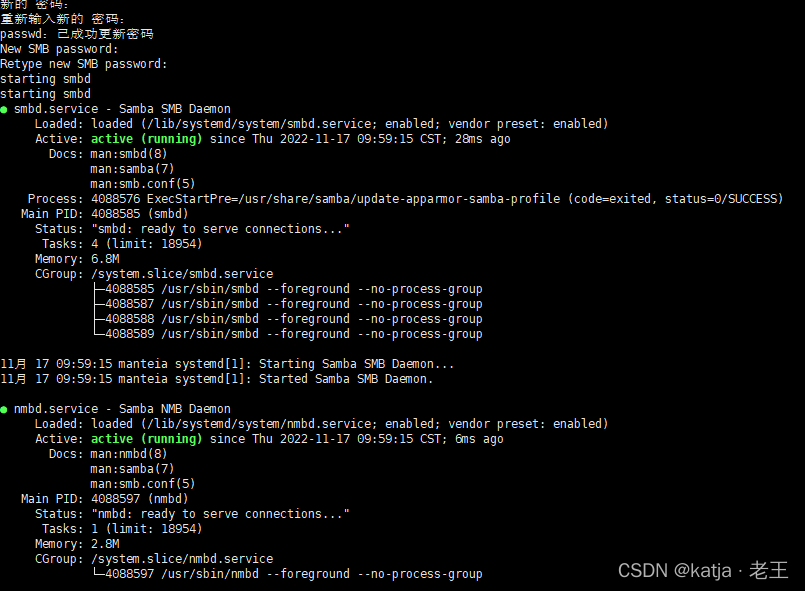
-
查看当前电脑ip
ip address: 我的是192.168.10.142 -
用其他电脑试试能否访问
- windows——
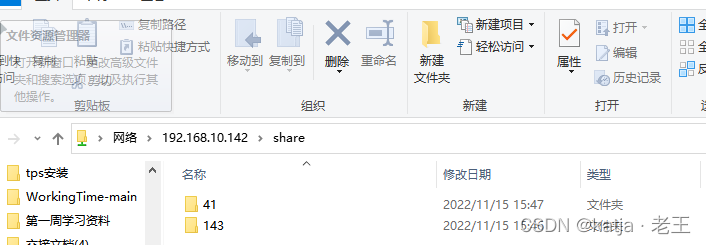
- linux ubuntu ——
smbclient //192.168.10.142
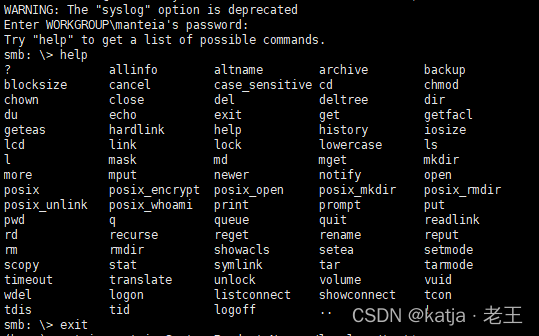
centos 是mbclient
如果没有就直接安装
如图就是成功了
失败
- NT_STATUS_HOST_UNREACHABLE
- 查看SMB配置文件是否正确
testparam /etc/samba/smb.conf

- 确认防火墙已经通过了samba和端口
(按照我的脚本应该没有问题)
- Failed to start smb.service: Unit smb.service not found
先人工看下安装失败的包是不是系统包,如果不是的话可以不用进行is_exist 判断,直接覆盖安装
覆盖安装的过程中可能会有个别的包提示失败,不用管,只要最后服务启动就行
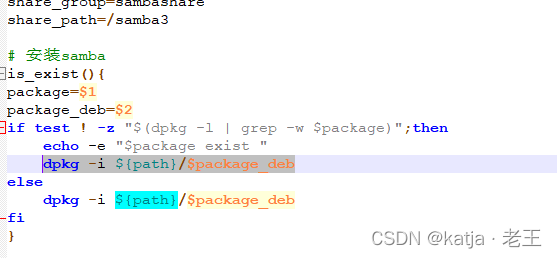
更新
- 2022-12-16
今天被告知突然不能连接了,我把日志级别调成了5,重启samba后发现了报错
pid_to_procid messaging_dgm_get_unique failed no such file or directory
搜了一下,是因为Ubuntu linux 中的apparmor 安全内核会把不属于home或者usershares的路径链接断开
所以需要加一下白名单
cd /etc/apparmor.d/local
sudo vim usr.sbin.smbd
在里面添加两行
"/samba3/" rk,
"/samba3/**" lrwk,
然后重启samba服务,再连就可以了
官方文档链接:https://wiki.archlinux.org/title/Samba#Permission_issues_on_AppArmor
- 2022-12-28
今天安装后运行不起来,首先测试配置文件是否正确
cd /etc/samba
testparm
有个警告提示security的位置不在global下,于是给挪上去
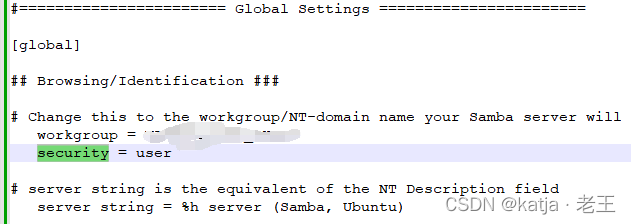
然后再testparm没报错了,但是再启动还是提示 Job for smbd.service failed because the control process exited with error code

于是把smb.conf的日志级别调成6

再次启动后,查看日志 : /var/log/samba/log.smbd
这时就会提示 : directory_create_or_exist_strict: invalid ownership on directory /var/lib/samba/private/msg.sock
说该目录的归属用户错误,samba 是以root运行,所属的文件目录理应也是root
但我去这个目录下看了下,果然不是root,所以需要修改
sudo chown -R root.root /var/lib/samba/private/msg.sock
还有可能报其他路径归属权的错误,也是一样的操作
除此之外,还可能报权限错误问题 : invalid permissions on directory '/run/samba/msg.lock': has 0777 should be 0755
sudo chmod -R 0755 /run/samba/msg.lock
多次反复 开启-看日志-修改 后,最终成功启动








 本文提供了一个详细的Samba服务器搭建教程,包括安装Samba所需的软件包、配置防火墙、创建共享目录及用户等步骤,并解决了常见问题。
本文提供了一个详细的Samba服务器搭建教程,包括安装Samba所需的软件包、配置防火墙、创建共享目录及用户等步骤,并解决了常见问题。
















 2万+
2万+

 被折叠的 条评论
为什么被折叠?
被折叠的 条评论
为什么被折叠?








